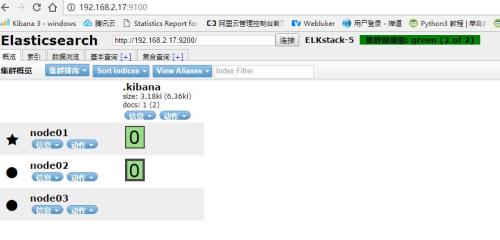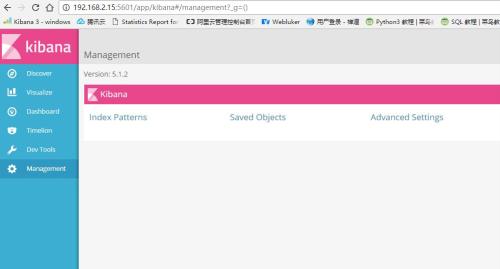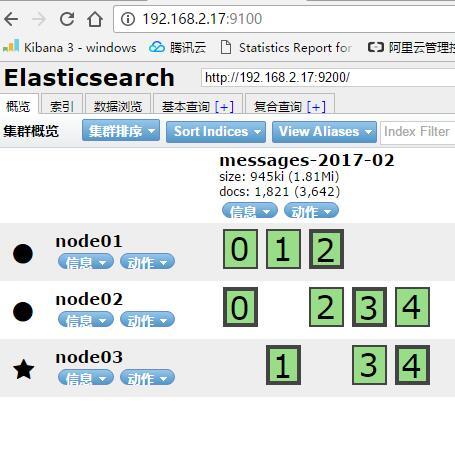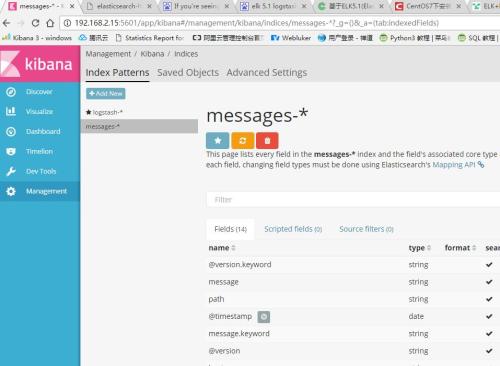Elasticstack 5.1.2 集群日志系统部署及实践
一、ELK Stack简介
ELK Stack 是Elasticsearch、Logstash、Kibana三个开源软件的组合,在实时数据检索和分析场合,三者通常是配合共用的。
可参考:https://www.elastic.co/products
二、Elasticstack重要组件
Elasticsearch: 准实时索引
Logtash: 收集数据,配置使用 Ruby DSL
Kibana 展示数据,查询聚合,生成报表
Kafka 消息队列,做为日志接入的缓冲区
三、Elasticstack工作流程
简要说明:
1)日志机器上部署logstash服务,用于监控并收集日志,然后,将收集到的日志发送到broker上。
2)Indexer会将这些日志收集到一起,统一发送到Elasticsearch上进行存储。
3)最后Kibana会将需要的数据进行展示,可以进行自定义搜索
四、环境准备
系统:centos 7.2
JDK: 1.8.0_111
filebeat: 5.1.2
logstash: 5.1.2
elasticsearch: 5.1.2 (注:ELK stack 5.1以上版本JDK必须是1.8以上)
kibana: 5.1.2
X-Pack:5.1
kafka: 2.11-0.10.1.0
测试服务器准备:
主机名称:node01 IP:192.168.2.14 职责:主机节点以及数据节点、kafka/logstash
主机名称:node02 IP: 192.168.2.15 职责:主机节点以及数据节点、kibana
主机名称:node03 IP: 192.168.2.17 职责:主机节点以及数据节点、Elasticstack-head插件
主机名称:test IP: 192.168.2.70 职责:客户端
注:分配内存建议大于2G
测试服务器设置:
配置hosts(/etc/hosts)
192.168.2.14 node01
192.168.2.15 node02
192.168.2.17 node03
关闭防火墙&Sellinux
配置yum源:
#yum -y install epel-release
时间同步:
#rpm -qa |grep chrony
配置时间同步源:# vi /etc/chrony.conf
# Please consider joining the pool (http://www.pool.ntp.org/join.html).
server 0.rhel.pool.ntp.org iburst
server 1.rhel.pool.ntp.org iburst
server 10.100.2.5 iburst
重启时间同步服务:# systemctl restart chronyd.service
node01和node02安装配置JDK:
#yum install java-1.8.0-openjdk java-1.8.0-openjdk-devel #安装openjdk
1)标准方式配置环境变量:
vim /etc/profile
将下面的三行粘贴到 /etc/profile中:
export JAVA_HOME=/usr/lib/jvm/java-1.8.0-openjdk-1.8.0.121-0.b13.el7_3.x86_64
export CLASSPATH=.:$JAVA_HOME/jre/lib/rt.jar:$JAVA_HOME/lib/dt.jar:$JAVA_HOME/lib/tools.jar
export PATH=$PATH:$JAVA_HOME/bin
2)保存关闭后,执行:source /etc/profile #让设置立即生效。
[root@~]# echo $JAVA_HOME
[root@ ~]# echo $CLASSPATH
[root@ ~]# echo $PATH
测试是否安装配置成功
# java -version
openjdk version "1.8.0_121"
OpenJDK Runtime Environment (build 1.8.0_121-b13)
OpenJDK 64-Bit Server VM (build 25.121-b13, mixed mode)
3)下载相应的组件到/home/soft
#wget https://artifacts.elastic.co/downloads/elasticsearch/elasticsearch-5.1.2.zip
#wget https://artifacts.elastic.co/downloads/kibana/kibana-5.1.2-linux-x86_64.tar.gz
#wget https://artifacts.elastic.co/downloads/logstash/logstash-5.1.2.zip
#wget http://apache.mirrors.lucidnetworks.net/kafka/0.10.1.0/kafka_2.11-0.10.1.0.tgz
五、node01节点安装部署elasticsearch
1、创建elk用户、组
[root@node01 soft]groupadd elk
[root@node01 soft]useradd -g elk elk
2、elasticsearch解压至/usr/local/目录下
[root@node01 soft]#unzip elasticsearch-5.1.2.zip -d /usr/local/
3、创建data/db和data/logs分别存储数据文件和日志文件
[root@node01 soft]# mkdir -pv /data/{db,logs}
4、授权data/db和data/logs、/usr/local/elasticsearch-5.1.2文件夹elk用户及用户组读取权限
[root@node01 soft]chown elk:elk /usr/local/elasticsearch-5.1.2 -R
[root@node01 soft]chown elk:elk /data/{db,logs} -R
5、编辑/usr/local/elasticsearch-5.1.2/config/elasticsearch.yml 修改为如下参数:
[root@node01 config]# vim elasticsearch.yml
cluster.name: ELKstack-5
node.name: node01
path.data: /data/db
path.logs: /data/logs
bootstrap.memory_lock: true
network.host: 0.0.0.0
http.port: 9200
discovery.zen.ping.unicast.hosts: ["192.168.2.14","192.168.2.15","192.168.2.17"]
discovery.zen.minimum_master_nodes: 2
xpack.security.enabled: false #关闭es认证 与kibana对应,不然后面安装x-pack需要用户名密码验证
注:
cluster.name: ELKstack-5 #集群的名字(可任意取名称)
node.name: node01 #换个节点名字
network.host: 0.0.0.0 #监听地址,0.0.0.0表示任意机器可以访问
http.port: 9200 #可默认
http.cors.enabled: true #head插件可以访问es
http.cors.allow-origin: "*"
discovery.zen.ping.unicast.hosts: 集群中master节点的初始列表,可以通过这些节点来自动发现新加入集群的节点
discovery.zen.minimum_master_nodes: 选举一个Master需要多少个节点(最少候选节点数),一般设置成 N/2 + 1,N是集群中节点的数量
xpack.security.enabled: false #关闭es认证 与kibana对应,禁用了认证功能,如果启用了认证,访问时需要指定用户名密码
6、根据elk运行环境,需要修改以下参数(修改参数以后建议重启机器)
1)[root@node01 config]# vim /etc/security/limits.conf #修改限制参数,允许elk用户访问mlockall
# allow user 'elk mlockall
elk soft memlock unlimited
elk hard memlock unlimited
* soft nofile 65536
* hard nofile 131072
* soft nproc 2048
* hard nproc 4096
2)[root@node01 config]# vim /etc/security/limits.d/20-nproc.conf #修改可打开的文件描述符的最大数(软限制)
修改如下内容:
* soft nproc 4096
#修改为
* soft nproc 2048
3)[root@node01 config]# vim /etc/sysctl.conf #限制一个进程可以拥有的VMA(虚拟内存区域)的数量
添加下面配置:
vm.max_map_count=655360
[root@node01 config]# sysctl -p #刷新修改参数使其生效
4)修改jvm空间分配,因为elasticsearch5.x默认分配jvm空间大小为2g
[root@node01 elasticsearch-5.1.2]# vim config/jvm.options
-Xms2g
-Xmx2g
修改为
[root@node01 elasticsearch-5.1.2]# vim config/jvm.options
-Xms512m
-Xmx512m
不然会报以下错误:
OpenJDK 64-Bit Server VM warning: INFO: os::commit_memory(0x000000008a660000, 1973026816, 0) failed; error='Cannot allocate memory' (errno=12)
#
# There is insufficient memory for the Java Runtime Environment to continue.
# Native memory allocation (mmap) failed to map 1973026816 bytes for committing reserved memory.
# An error report file with more information is saved as:
# /usr/local/elasticsearch-5.1.2/hs_err_pid11986.log
5)启动elasticsearch服务,注:elasticsearch默认不允许root用户启动服务,切换至普通用户启动
[root@node01 elasticsearch-5.1.2]#su - elk
[elk@node01 elasticsearch-5.1.2]$cd /usr/local/elasticsearch-5.1.2
[elk@node01 elasticsearch-5.1.2]$nohup ./bin/elasticsearch &
[elk@node01 elasticsearch-5.1.2]$./elasticsearch -d #ElasticSearch后端启动命令
注:停止服务(ps -ef |grep elasticsearch 、kill PID)
6)启动后查看进程是否监听端口9200/9300,并且浏览器访问http://192.168.2.14:9200/,是否正常输出es集群信息等
[root@node01 ~]# ss -tlnp |grep '9200'
LISTEN 0 128 :::9200 :::* users:(("java",pid=2288,fd=113)
[root@node01 ~]# curl http://192.168.2.14:9200
{
"name" : "node01",
"cluster_name" : "ELKstack-5",
"cluster_uuid" : "jZ53M8nuRgyAKqgQCDG4Rw",
"version" : {
"number" : "5.1.2",
"build_hash" : "c8c4c16",
"build_date" : "2017-01-11T20:18:39.146Z",
"build_snapshot" : false,
"lucene_version" : "6.3.0"
},
"tagline" : "You Know, for Search"
}
六、类似node01节点安装elasticsearch部署node02、node03节点
1、安装部署node02节点elasticsearch
1)编辑/usr/local/elasticsearch-5.1.2/config/elasticsearch.yml 修改为如下参数:
[root@node02 config]# vim elasticsearch.yml
cluster.name: ELKstack-5
node.name: node02
path.data: /data/db
path.logs: /data/logs
bootstrap.memory_lock: true
network.host: 0.0.0.0
http.port: 9200
discovery.zen.ping.unicast.hosts: ["192.168.2.14","192.168.2.15","192.168.2.17"]
discovery.zen.minimum_master_nodes: 2
xpack.security.enabled: false #关闭es认证 与kibana对应
注:其他配置部署同node01
2、安装部署node03节点elasticsearch
1)编辑/usr/local/elasticsearch-5.1.2/config/elasticsearch.yml 修改为如下参数:
[root@node02 config]# vim elasticsearch.yml
cluster.name: ELKstack-5
node.name: node03
path.data: /data/db
path.logs: /data/logs
bootstrap.memory_lock: true
network.host: 0.0.0.0
http.port: 9200
discovery.zen.ping.unicast.hosts: ["192.168.2.14","192.168.2.15","192.168.2.17"]
discovery.zen.minimum_master_nodes: 2
xpack.security.enabled: false #关闭es认证 与kibana对应
注:其他配置部署同node01
3、3个节点(node01,node02,node03)启动后,查看集群是否正常,节点是否正常
常用查询命令如下:
查看集群状态:curl -XGET http://localhost:9200/_cat/health?v
查看集群节点:curl -XGET http://localhost:9200/_cat/nodes?v
查询索引列表:curl -XGET http://localhost:9200/_cat/indices?v
创建索引:curl -XPUT http://localhost:9200/customer?pretty
查询索引:curl -XGET http://localhost:9200/customer/external/1?pretty
删除索引:curl -XDELETE http://localhost:9200/customer?pretty
[root@node01 ~]# curl -XGET http://localhost:9200/_cat/health?v
epoch timestamp cluster status node.total node.data shards pri relo init unassign pending_tasks max_task_wait_time active_shards_percent
1486384674 20:37:54 ELKstack-5 green 3 3 0 0 0 0 0 0 - 100.0%
[root@node01 ~]# curl -XGET http://localhost:9200/_cat/nodes?v
ip heap.percent ram.percent cpu load_1m load_5m load_15m node.role master name
192.168.2.17 22 94 3 0.58 0.55 0.27 mdi * node03
192.168.2.15 22 93 0 0.59 0.60 0.29 mdi - node02
192.168.2.14 22 93 1 0.85 0.77 0.37 mdi - node01
七、node3(192.168.2.17)节点上安装head插件(由于elasticsearch5.0版本变化较大,目前elasticsearch5.0 暂时不支持直接安装)
1、在从github上面下载代码,因此先要安装git,授权文件和目录(777)
[root@node03 local]# yum install git
[root@node03 local]# git clone git://github.com/mobz/elasticsearch-head.git
[root@node03 local]# chmod 777 -R elasticsearch-head/*
2、下载Node.js,并解压,配置进环境变量
[root@node03 soft]# wget https://npm.taobao.org/mirrors/node/latest-v4.x/node-v4.6.1-linux-x64.tar.gz
[root@node03 soft]# tar -xvf node-v4.6.1-linux-x64.tar.gz #解压至当前目录
[root@node03 soft]#vim /etc/profile
添加如下: export PATH=/home/soft/node-v4.6.1-linux-x64/bin:$PATH
[root@node03 soft]#source /etc/profile #使配置文件生效。
3、在/usr/local/elasticsearch-head/目录下,进行npm install 使用node.js安装
[root@node03 elasticsearch-head]# npm install -g cnpm --registry=https://registry.npm.taobao.org
[root@node03 elasticsearch-head]# npm install grunt --save-dev
4、修改目录/usr/local/elasticsearch-head/Gruntfile.js
connect: {
server: {
options: {
port: 9100,
hostname: '0.0.0.0',
base: '.',
keepalive: true
}
}
}
增加hostname属性,设置为*或'0.0.0.0'
5、修改/usr/local/elasticsearch-5.1.2/config/elasticsearch.yml配置文件,增加一下配置,重新启动ES服务
# 以下两个为允许跨域,主要是5.1版本的head插件和以往安装的不一样
http.cors.enabled: true
http.cors.allow-origin: "*"
6、修改目录/usr/local/elasticsearch/plugins/head/_site/Gruntfile.js
connect: {
server: {
options: {
port: 9100,
hostname: '0.0.0.0',
base: '.',
keepalive: true
}
}
}
增加hostname属性,设置为*或'0.0.0.0'
7、修改/usr/local/elasticsearch-head/_site/app.js连接地址:
修改head的连接地址:
this.base_uri = this.config.base_uri || this.prefs.get("app-base_uri") || "http://localhost:9200";
把localhost修改为es的服务器地址,如:
this.base_uri = this.config.base_uri || this.prefs.get("app-base_uri") || "http://192.168.2.17:9200";
8、修改/usr/local/elasticsearch-5.1.2/config/elasticsearch.yml配置文件,增加一下配置,重新启动ES服务
# 以下两个为允许跨域,主要是5.1版本的head插件和以往安装的不一样
http.cors.enabled: true
http.cors.allow-origin: "*"
9、解决依赖并启动服务
执行npm install下载依赖的包:
[root@node03 elasticsearch-head]#npm install
[root@node03 elasticsearch-head]#./node_modules/grunt/bin/grunt serverb & #后台启动服务
测试访问:http://192.168.2.17:9100/
八、node2(192.168.2.15)节点上安装部署kibana
1、kibana解压至/usr/local/目录下
[root@node02 soft]# tar -xvf kibana-5.1.2-linux-x86_64.tar.gz -C /usr/local/
2、修改/usr/local/kibana-5.1.2-linux-x86_64/config/kibana.yml配置文件,如下:并启动kibana服务
[root@node02 soft]#vim /usr/local/kibana-5.1.2-linux-x86_64/config/kibana.yml
server.port: 5601
server.host: "192.168.2.15"
elasticsearch_url: "http://192.168.2.15:9200"
xpack.security.enabled: false #关闭认证,为后面kibana增加x-pack组件免去用户名密码认证
[root@node02 kibana-5.1.2-linux-x86_64]# bin/kibana > /var/log/kibana.log 2>&1 & #启动服务
九、配置客户端test节点(192.168.2.70)
1、安装配置JDK(同node01~node03,这里不再阐述)
2、拷贝logstash至客户端,并解压至/usr/local/目录下
[root@node02 config]# scp /home/soft/logstash-5.1.2.zip root@192.168.2.70:/home/soft/
[root@test soft]#unzip logstash-5.1.2.zip -d /usr/local/
3、编辑logstash服务管理脚本(配置路径可根据实际情况修改)
[root@test logstash-5.1.2]# mkdir logs etc #创建目录logs,etc
[root@test logstash-5.1.2]# vim /etc/init.d/logstash
[root@test logstash-5.1.2]# chmod +x /etc/init.d/logstash #添加权限
脚本如下:
#!/bin/bash
#chkconfig: 2345 55 24
#description: logstash service manager
#auto: Maoqiu Guo
FILE='/usr/local/logstash-5.1.2/etc/*.conf' #logstash配置文件
LOGBIN='/usr/local/logstash-5.1.2/bin/logstash agent --verbose --config' #指定logstash配置文件的命令
LOCK='/usr/local/logstash-5.1.2/locks' #用锁文件配合服务启动与关闭
LOGLOG='--log /usr/local/logstash-5.1.2/logs/stdou.log' #日志
START() {
if [ -f $LOCK ];then
echo -e "Logstash is already �33[32mrunning�33[0m, do nothing."
else
echo -e "Start logstash service.�33[32mdone�33[m"
nohup ${LOGBIN} ${FILE} ${LOGLOG} &
touch $LOCK
fi
}
STOP() {
if [ ! -f $LOCK ];then
echo -e "Logstash is already stop, do nothing."
else
echo -e "Stop logstash serivce �33[32mdone�33[m"
rm -rf $LOCK
ps -ef | greplogstash | grep -v "grep" | awk '{print $2}' | xargskill -s 9 >/dev/null
fi
}
STATUS() {
psaux | greplogstash | grep -v "grep" >/dev/null
if [ -f $LOCK ] && [ $? -eq 0 ]; then
echo -e "Logstash is: �33[32mrunning�33[0m..."
else
echo -e "Logstash is: �33[31mstopped�33[0m..."
fi
}
TEST(){
${LOGBIN} ${FILE} --configtest
}
case "$1" in
start)
START
;;
stop)
STOP
;;
status)
STATUS
;;
restart)
STOP
sleep 2
START
;;
test)
TEST
;;
*)
echo "Usage: /etc/init.d/logstash (test|start|stop|status|restart)"
;;
esac
4、Logstash 向es集群写数据,并测试
1)、在/usr/local/logstash-5.1.2/etc/目录下编写一个logstash配置文件logstash.conf
[root@test etc]# cat logstash.conf
input { #数据的输入从标准输入
stdin {}
}
output { #数据的输出我们指向了es集群
elasticsearch {
hosts => ["192.168.2.14:9200","192.168.2.15:9200",192.168.2.17:9200"]#es主机的ip及端口
}
}
[root@test etc]# /usr/local/logstash-5.1.2/bin/logstash -f logstash.conf -t #查看配置是否正常
Sending Logstash's logs to /usr/local/logstash-5.1.2/logs which is now configured via log4j2.properties
Configuration OK
2)测试数据ES,修改logstash.conf配置文件,把messages输出到日志中,启动logstash服务
[root@test etc]# cat logstash.conf
input {#这里的输入使用的文件,即日志文件messsages
file {
path => "/var/log/messages"#这是日志文件的绝对路径
start_position => "beginning"#这个表示从messages的第一行读取,即文件开始处
}
}
output {#输出到es
elasticsearch {
hosts => ["192.168.2.14:9200","192.168.2.15:9200",192.168.2.17:9200"]
index => "messages-%{+YYYY-MM}"#这里将按照这个索引格式来创建索引
}
}
[root@test etc]# /usr/local/logstash-5.1.2/bin/logstash -f logstash.conf 或[root@test etc]# /etc/init.d/logstash start
3)验证插件head和kibana是否从ES集群接收到数据并展示
head插件看到相关索引http://192.168.2.17:9100/
kibana根据中相关索引,新建图片http://192.168.2.15:5601/
九、安装部署Kafka消息队列
1、Kafka是一个分布式、可分区、可复制的消息系统, 在Kafka集群中,没有『中心主节点』的概念,集群中所有的服务器都是对等的,因此可以在不做任何配置更改的情况下对服务器进行添加和删除,同样的消息生产者和消费都也能做到随意重启和机器的上下线。
2、Kafka相关概念
kafka核心组件工作流程
Consumer:用于从Broker中取出/消费Message
Producer:用于往Broker中发送/生产Message
Broker:Kafka中使用Broker来接受Producer和Consumer的请求,并把Message持久化到本地磁盘。每个Cluster当中会选举出一个Broker来担任Controller,负责处理Partition的Leader选举,协调Partition迁移等工作
以上组件在分布式环境下均可以是多个,支持故障转移。同时ZooKeeper仅和broker和consumer相关。broker的设计是无状态的,消费的状态信息依靠消费者自己维护,通过一个offset偏移量。client和server之间通信采用TCP协议。
发布消息通常有两种模式:队列模式(queuing)和发布-订阅模式(publish-subscribe)。队列模式中,consumers 可以同时从服务端读取消息,每个消息只被其中一个 consumer 读到;发布-订阅模式中消息被广播到所有的 consumer 中。更常见的是,每个 topic 都有若干数量的 consumer 组,每个组都是一个逻辑上的『订阅者』,为了容错和更好的稳定性,每个组由若干 consumer 组成。这其实就是一个发布-订阅模式,只不过订阅者是个组而不是单个 consumer。
3、kafka的Topic与Partition工作流程
消息是按照主题来提交到Partition当中的。Partition当中的消息是有序的,consumer从一个有序的分区消息队列中顺序获取消息。相关名次定义如下:
Topic:用于划分Message的逻辑概念,一个Topic可以分布在多个Broker上
Partition:是Kafka中横向扩展和一切并行化的基础,每个Topic都至少被切分为1个Partition
offset:消息在Partition中的编号,编号顺序不跨Partition
分区目的:Kafka中采用分区的设计有几个目的。一是可以处理更多的消息,不受单台服务器的限制。Topic拥有多个分区意味着它可以不受限的处理更多的数据。第二,分区可以作为并行处理的单元
offset:由消费者控制offset,因此分区本身所在broker是无状态的。消费者可以自由控制offset,很灵活
同个分区内有序消费:每一个分区都是一个顺序的、不可变的消息队列, 并且可以持续的添加。分区中的消息都被分配了一个序列号,称之为偏移量(offset),在每个分区中此偏移量都是唯一的
4、node01节点(192.168.2.14)上安装部署kafka(这里测试zookeeper没有集群,实际生产环境建议使用集群)
注:安装配置JDK环境这里省略,类同node01等节点
1)kafka解压至/usr/local/目录下,并创建链接kafka
[root@node01 soft]# tar -xvf kafka_2.11-0.10.1.0.tgz -C /usr/local/
[root@node01 soft]# cd /usr/local/
[root@node01 local]# ln -sv kafka_2.11-0.10.1.0 kafka
2)创建zookeeper存储目录,修改/usr/local/kafka/config/目录下zookeeper.propertie配置文件
[root@node01 local]# mkdir /data/zookeeper
[root@node01 local]#vim /usr/local/kafka/config/zookeeper.propertie
修改配置如下:
dataDir=/data/zookeeper
# the port at which the clients will connect
tickTime=2000 #维持心跳的时间间隔
initLimit=20
syncLimit=10
注:如果zookeeper集群的话,必须标识再配置文件server.2,server.*不同名称并且在/data/zookeeper目录下创建myid文件,里面的内容为数字,用于标识主机,如果这个文件没有的话,zookeeper是没法启动的
如:[root@kafka1 ~]# echo 2 > /data/zookeeper/myid
3)修改kafka配置/usr/local/kafka/config/目录下server.properties文件
broker.id=0 # 唯一,填数字,如果是集群该值必须不同如:2、3、4
listeners=PLAINTEXT://:9092 #监听端口
advertised.listeners=PLAINTEXT://192.168.2.14:9092 # 唯一,填服务器IP
log.dir=/data/kafka-logs # 该目录可以不用提前创建,在启动时自己会创建
zookeeper.connect=192.168.2.14:2181 #这个就是zookeeper的ip及端口
num.partitions=16 # 需要配置较大 分片影响读写速度
log.dirs=/data/kafka-logs # 数据目录也要单独配置磁盘较大的地方
log.retention.hours=168 # 时间按需求保留过期时间 避免磁盘满
4)启动kafka和zookeeper服务(先要启动zookeeper再启动kafka,如果是zookeeper集群如是)
[root@kafka1 ~]# /usr/local/kafka/bin/zookeeper-server-start.sh /usr/local/kafka/config/zookeeper.properties & #zookeeper启动命令
注:/usr/local/kafka/bin/zookeeper-server-stop.sh #暂停服务
[root@node01 config]# ss -tlnp |grep '2181' #启动正常
LISTEN 0 50 :::2181 :::* users:(("java",pid=3118,fd=88))
[root@node01 config]# nohup /usr/local/kafka/bin/kafka-server-start.sh /usr/local/kafka/config/server.properties &
#kafka启动的命令
或
#/usr/local/kafka/bin/kafka-server-start.sh /usr/local/kafka/config/server.properties > /dev/null &
注:/usr/local/kafka/bin/kafka-server-stop.sh #暂停服务
5)kafka创建一个主题
[root@node01 kafka]#bin/kafka-topics.sh --create --zookeeper 192.168.2.14:2181 --replication-factor 1 --partitions 1 --topic linuxtest
#注意:factor大小不能超过broker数
[root@node01 kafka]# bin/kafka-topics.sh --list --zookeeper 192.168.2.14:2181 #查看主题
linuxtest
[root@node01 kafka]#bin/kafka-topics.sh --describe --zookeeper 192.168.2.14:2181 --topic linuxtest
Topic:linuxtestPartitionCount:1ReplicationFactor:1Configs:
Topic: linuxtestPartition: 0Leader: 0Replicas: 0Isr: 0
6)发送消息,这里使用的是生产者角色
[root@node01 kafka]#bin/kafka-console-producer.sh --broker-list 192.168.2.14:9092 --topic linuxtest
This is a messages
welcometo kafka
7)接收消息,这里使用的是消费者角色
[root@node01 kafka]#bin/kafka-console-consumer.sh --zookeeper 192.168.2.14:2181 --topic linuxtest --from-beginning
This is a messages
welcometo kafka
5、修改客户端test节点logstash.conf配置文件,输出改到kafka上面,将数据写入到kafka中,重启logstash服务
[root@test etc]# cat logstash.conf
input { #这里的输入还是定义的是从日志文件输入
file {
type => "message"
path => "/var/log/messages"
start_position => "beginning"
}
}
output {
#stdout { codec => rubydebug } #这是标准输出到终端,可以用于调试看有没有输出,注意输出的方向可以有多个
kafka { #输出到kafka
bootstrap_servers => "192.168.2.14:9092" #他们就是生产者
topic_id => "linux-messages" #这个将作为主题的名称,将会自动创建
compression_type => "snappy" #压缩类型
}
}
[root@test etc]#/usr/local/logstash-5.1.2/bin/logstash -f logstash.conf > /dev/null &
6、从kafka中读取数据后输出到ES机器,node01安装部署Logstash,安装步骤不再赘述;注意这里的日志主题名称“linuxtest”,并启动服务
[root@node01 etc]# more logstash.conf
input {
kafka {
zk_connect => "192.168.2.14:2181" #消费者们
topic_id => "linuxtest"
codec => plain
reset_beginning => false
consumer_threads => 5
decorate_events => true
}
}
output {
elasticsearch {
hosts => ["192.168.2.14:9200","192.168.2.15:9200","192.168.2.17:9200"]
index => "linux-messages-%{+YYYY-MM}"
}
}
[root@node01 etc]# /usr/local/logstash/bin/logstash -f logstash.conf > /dev/null & #启动服务
7、验证在test客户端上写入测试内容
[root@webserver1etc]# echo "test-linux-messages到es集群!!!" >> /var/log/messages
#启动logstash,让其读取messages中的内容
十、安装部署X-Pack(需付费X-Pack License(可注册1年免费 License))
1、x-pack是elasticsearch的一个扩展包,将安全,警告,监视,图形和报告功能捆绑在一个易于安装的软件包中,虽然x-pack被设计为一个无缝的工作,但是你可以轻松的启用或者关闭一些功能。
注:以下为license 注册信息
curl -XPUT -u elastic:password 'http://<host>:<port>/_xpack/license' -d @license.json
@license.json 申请得到的json文件,复制文件中的所有内容,粘贴在此。
如果提示需要acknowledge,则设置为true
curl -XPUT -u elastic:password 'http://<host>:<port>/_xpack/license?acknowledge=true' -d @license.json
查看安装结果信息
curl -XGET -u elastic:password 'http://<host>:<port>/_license'
不同版本功能
https://www.elastic.co/subscriptions
X-Pack监控组件使您能够通过Kibana轻松监控Elasticsearch。 您可以实时查看集群运行状况和性能,以及分析过去的集群,索引和节点指标。 此外,您可以监控Kibana本身的性能。在群集上安装X-Pack时,监视代理会在每个节点上运行,以从Elasticsearch收集索引指标。 通过在Kibana中安装X-Pack,您可以通过一组专用仪表板查看监视数据。
x-pack安装之后有一个超级用户elastic ,其默认的密码是changeme,拥有对所有索引和数据的控制权,可以使用该用户创建和修改其他用户,当然这里可以通过kibana的web界面进行用户和用户组的管理。
X-pack的elk之间的数据传递保护,如:安装完x-pack之后,我们就可以用我们所创建的用户来保护elk之间的数据传递.
如下:
1)kibana<——>elasticsearch
在kibana.yml文件中配置:
elasticsearch.username: “elastic”
elasticsearch.password: “changeme”
2)logstash<——>elasticsearch
在自己写的配置文件中定义
input {
stdin{}
beats{
port => 5044
}
}
output {
elasticsearch {
hosts => ["http://localhost:9200"]
user => elastic #必须有对应的用户/密码
password => changeme
}
stdout{
codec=>rubydebug
}
}
注:这里如果不进行相关配置的话,elk之间的数据传递就会出现问题
2、在各个ES集群节点/usr/local/elasticsearch-5.1.2/目录下以及kibana(本示例kibana在node02上)的/usr/local/kibana-5.1.2-linux-x86_64/
目录下安装X-Pack,并重启Kibana
[root@node01 elasticsearch-5.1.2]# bin/elasticsearch-plugin install x-pack
[root@node02 elasticsearch-5.1.2]# bin/elasticsearch-plugin install x-pack
[root@node03 elasticsearch-5.1.2]# bin/elasticsearch-plugin install x-pack
[root@node02 kibana-5.1.2-linux-x86_64]# bin/kibana-plugin install x-pack
[root@node02 kibana-5.1.2-linux-x86_64]# bin/kibana > /var/log/kibana.log 2>&1 & #kill进程后启动服务
注:卸载x-pack组件,#bin/elasticsearch-plugin remove x-pack
页面访问:http://192.168.2.15:5601,可以查看多了Monitoring选项,更多资料请参考官网
官方文档:https://www.elastic.co/guide/index.html
elasticsearch 权威指南:http://www.learnes.net/
ELK stack 权威指南:http://kibana.logstash.es/content/logstash/
ELK 开发指南:https://endymecy.gitbooks.io/elasticsearch-guide-chinese/content/index.html
****************************************************************************************************
常见问题总结:
#Java HotSpot(TM) 64-Bit Server VM warning: INFO: os::commit_memory(0x0000000085330000, 2060255232, 0) failed; error='Cannot allocate memory' (errno=12)
由于elasticsearch5.x默认分配jvm空间大小为2g,修改jvm空间分配
# vim config/jvm.options
-Xms2g
-Xmx2g
修改为
# vim config/jvm.options
-Xms512m
-Xmx512m
#max file descriptors [65535] for elasticsearch process is too low, increase to at least [65536]
ulimit -SHn 65536
vim /etc/security/limits.conf
* soft nofile 65536
* hard nofile 65536
* soft nproc 65536
* hard nproc 65536
* soft nofile 65536
* hard nofile 65536
* soft nproc 65536
* hard nproc 65536
* soft nofile 65536
* hard nofile 65536
#max number of threads [1024] for user [elasticsearch] is too low, increase to at least [2048]
修改 /etc/security/limits.d/90-nproc.conf
* soft nproc 1024
* soft nproc 2048
#max virtual memory areas vm.max_map_count [65530] is too low, increase to at least [262144]
修改/etc/sysctl.conf配置文件,
cat /etc/sysctl.conf | grep vm.max_map_count
vm.max_map_count=262144
如果不存在则添加
echo "vm.max_map_count=262144" >>/etc/sysctl.conf
本文出自 “一万小时定律” 博客,请务必保留此出处http://daisywei.blog.51cto.com/7837970/1896347






